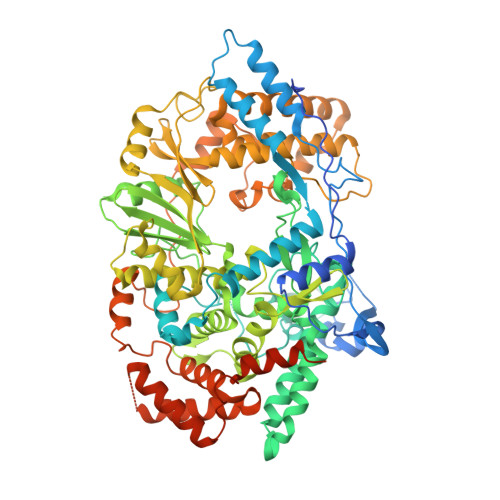Activation mechanism of a noncanonical RNA-dependent RNA polymerase.
Garriga, D., Navarro, A., Querol-Audi, J., Abaitua, F., Rodriguez, J.F., Verdaguer, N.(2007) Proc Natl Acad Sci U S A 104: 20540-20545
- PubMed: 18077388
- DOI: https://doi.org/10.1073/pnas.0704447104
- Primary Citation of Related Structures:
2PUS, 2R70, 2R72 - PubMed Abstract:
Two lineages of viral RNA-dependent RNA polymerases (RDRPs) differing in the organization (canonical vs. noncanonical) of the palm subdomain have been identified. Phylogenetic analyses indicate that both lineages diverged at a very early stage of the evolution of the enzyme [Gorbalenya AE, Pringle FM, Zeddam JL, Luke BT, Cameron CE, Kalmakoff J, Hanzlik TN, Gordon KH, Ward VK (2002) J Mol Biol 324:47-62]. Here, we report the x-ray structure of a noncanonical birnaviral RDRP, named VP1, in its free form, bound to Mg(2+) ions, and bound to a peptide representing the polymerase-binding motif of the regulatory viral protein VP3. The structure of VP1 reveals that the noncanonical connectivity of the palm subdomain maintains the geometry of the catalytic residues found in canonical polymerases but results in a partial blocking of the active site cavity. The VP1-VP3 peptide complex shows a mode of polymerase activation in which VP3 binding promotes a conformational change that removes the steric blockade of the VP1 active site, facilitating the accommodation of the template and incoming nucleotides for catalysis. The striking structural similarities between birnavirus (dsRNA) and the positive-stranded RNA picornavirus and calicivirus RDRPs provide evidence supporting the existence of functional and evolutionary relationships between these two virus groups.
Organizational Affiliation:
Institut de Biologia Molecular de Barcelona, Consejo Superior de Investigaciones Cientificas, Parc Científic de Barcelona, Josep Samitier 1-5, 08028 Barcelona, Spain.














